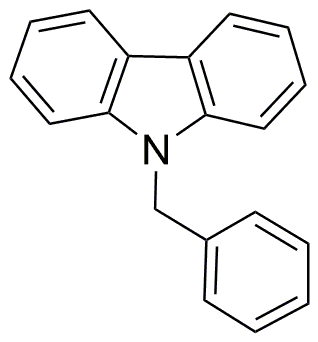9-Benzylcarbazole is widely utilized in research focused on:
- Organic Electronics: This compound serves as a key material in the development of organic light-emitting diodes (OLEDs), enhancing the efficiency and color quality of displays in consumer electronics.
- Photovoltaic Cells: It is used in the formulation of organic solar cells, contributing to improved energy conversion efficiency and stability, making renewable energy sources more viable.
- Pharmaceutical Research: The compound is explored for its potential anti-cancer properties, providing a basis for the development of new therapeutic agents in oncology.
- Polymer Chemistry: 9-Benzylcarbazole acts as a building block in synthesizing advanced polymers, which are used in various applications including coatings and adhesives, offering enhanced durability and performance.
- Fluorescent Probes: It is employed in the creation of fluorescent probes for biological imaging, allowing researchers to visualize cellular processes with high specificity and sensitivity.
General Information
Properties
Safety and Regulations
Applications
9-Benzylcarbazole is widely utilized in research focused on:
- Organic Electronics: This compound serves as a key material in the development of organic light-emitting diodes (OLEDs), enhancing the efficiency and color quality of displays in consumer electronics.
- Photovoltaic Cells: It is used in the formulation of organic solar cells, contributing to improved energy conversion efficiency and stability, making renewable energy sources more viable.
- Pharmaceutical Research: The compound is explored for its potential anti-cancer properties, providing a basis for the development of new therapeutic agents in oncology.
- Polymer Chemistry: 9-Benzylcarbazole acts as a building block in synthesizing advanced polymers, which are used in various applications including coatings and adhesives, offering enhanced durability and performance.
- Fluorescent Probes: It is employed in the creation of fluorescent probes for biological imaging, allowing researchers to visualize cellular processes with high specificity and sensitivity.
Documents
Safety Data Sheets (SDS)
The SDS provides comprehensive safety information on handling, storage, and disposal of the product.
Product Specification (PS)
The PS provides a comprehensive breakdown of the product’s properties, including chemical composition, physical state, purity, and storage requirements. It also details acceptable quality ranges and the product's intended applications.
Certificates of Analysis (COA)
Search for Certificates of Analysis (COA) by entering the products Lot Number. Lot and Batch Numbers can be found on a product’s label following the words ‘Lot’ or ‘Batch’.
*Catalog Number
*Lot Number
Certificates Of Origin (COO)
This COO confirms the country where the product was manufactured, and also details the materials and components used in it and whether it is derived from natural, synthetic, or other specific sources. This certificate may be required for customs, trade, and regulatory compliance.
*Catalog Number
*Lot Number
Safety Data Sheets (SDS)
The SDS provides comprehensive safety information on handling, storage, and disposal of the product.
DownloadProduct Specification (PS)
The PS provides a comprehensive breakdown of the product’s properties, including chemical composition, physical state, purity, and storage requirements. It also details acceptable quality ranges and the product's intended applications.
DownloadCertificates of Analysis (COA)
Search for Certificates of Analysis (COA) by entering the products Lot Number. Lot and Batch Numbers can be found on a product’s label following the words ‘Lot’ or ‘Batch’.
*Catalog Number
*Lot Number
Certificates Of Origin (COO)
This COO confirms the country where the product was manufactured, and also details the materials and components used in it and whether it is derived from natural, synthetic, or other specific sources. This certificate may be required for customs, trade, and regulatory compliance.


